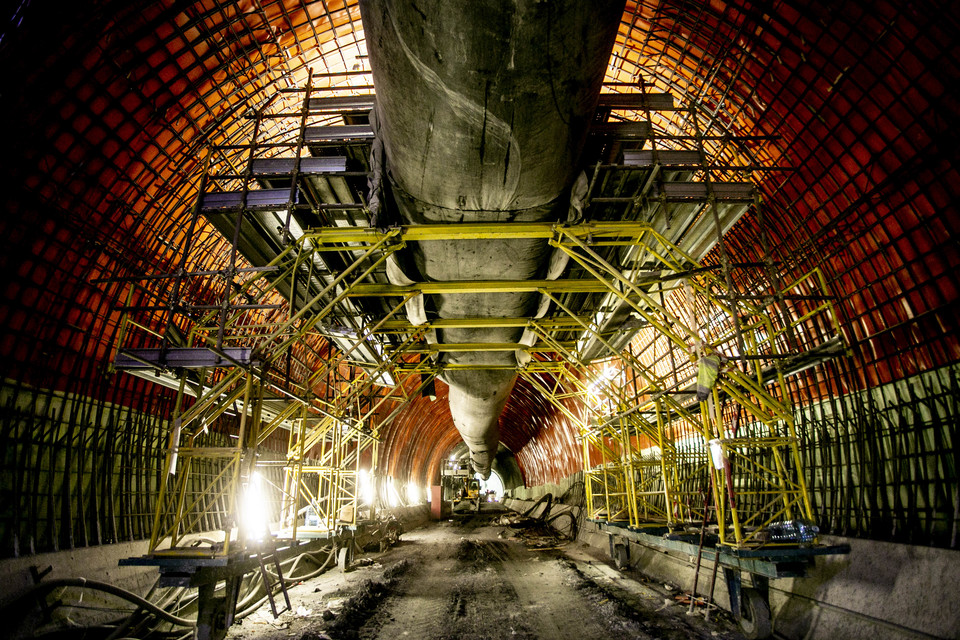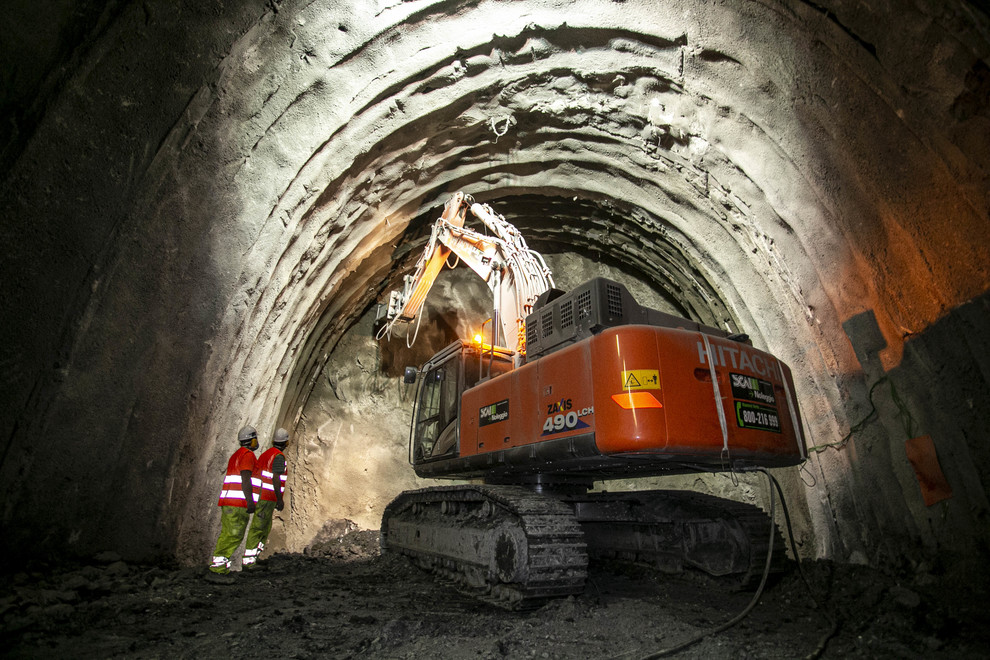It’s official: the moles (TBM) are out and have begun digging what will become Italy’s longest railway tunnel. These hefty cylinder-shaped monsters are over 100 metres (328 feet) in length and 10 metres (32 feet) in diameter, piercing the soil between Liguria and Piedmont, digging a new and efficient high-speed line that will connect Genoa to Milan in just 50 minutes. That’s half the time currently required to travel between the two cities.
Called the Terzo Valico Giovi, the 53-kilomtre (33-mile) route is part of Europe’s intricate, high-speed TEN-T network, which recently marked a watershed moment in its history. In the town of Serravalle Scrivia, Minister of Infrastructure and Transport Paola De Micheli and Webuild Group CEO Pietro Salini celebrated a double breakthrough—specifically, the opening of two tunnels that will facilitate direct connection between the worksites along a 17-kilometer (11-mile) stretch.
“We are here today to take pride in a ‘double breakthrough,’” said Pietro Salini. “The opening of these two tunnels is a testament to the extraordinary skills of many people, whom I thank for the incredible work they have done.”
Salini’s statement was a nod to the workers, technicians, and engineers who are contributing their efforts to the Terzo Valico Giovi, just as a giant team did for the San Giorgio Bridge in Genoa. Today, factoring in both direct and peripheral personnel, some 5,000 people are involved. The project is a major development opportunity and an infrastructurally strategic move, as well as a response to the demand for work in these uncertain times.

Meeting of the moles at Terzo Valico
The moles have succeeded yet again. The breakthrough celebrated a few days ago concerns the newly completed excavation of two tunnels: first, the Galleria di Valico. Once finished, it will be just under 27 kilometers (7 miles) long, a record for Italy. Digging along this route has been particularly complex, in part due to the Camerone di Valico Nord, an “underground cathedral” some30 meters (98 feet) wide, 22 metres (72 feet) high, and with a total surface area of 540 square meters (5813 square feet).
The second breakthrough was for the approximately 7 kilometre (4 mile) even track of the Galleria Serravalle. Crucial to this undertaking was the “Giovanna” tunnel boring machine, 115 metres (377 feet) long and 10 metres (33 feet) in diameter, but more importantly, responsible for roughly 6-7 kilometres (4.2 miles) of excavation.
“Giovanna’s” excavation presented some challenges because the route passes under foundations of buildings such as the Serravalle Outlet, as well as infrastructure like the historic Genoa-Turin railway.
“Our tunnels, especially those of the Valico, – says the engineer Nicola Meistro, general manager of the COCIV Consortium and Webuild’s Area Manager – have to go through very resistant materials so, during the excavations, we need to intensify the monitoring systems so that we can always calibrate the project and counteract any resistance exerted by the mountain, which can sometimes happen very rapidly. /…..
We therefore employ a series of engineers who check the results of the monitoring system twenty-four hours a day and calibrate the actions to be taken in the excavation as required.”
Innovative monitoring systems were put in place to deal with this, with on-site technicians using them both above and below ground. In short, operations were challenging, but the team capably met challenges to help create a new facilitator of regional connections in Northern Italy, extending beyond it to the rest of Europe.
Terzo Valico: the high-speed Italian rail line serving Europe
While the Terzo Valico dei Giovi will expedite travel between Genoa and Milan in a sustainable way, this new link is only one part of its impact. Its 52 kilometres (33 miles) are part of the Rhine-Alpine corridor, one of the axes of the TEN-T network, aimed at connecting Genoa with Rotterdam (and, in turn, the North Sea with the Mediterranean).
To accomplish this, the new line will be connected to existing lines through four interconnections in Voltri, Genoa – Parco Campasso, Novi Ligure and Tortona. The Consorzio COCIV is managing construction with leadership from the Webuild Group. Valued at 6.9 billion euro, the project also comprises the Genoa Railway Node, a system of inter-city connections offering high-speed travel all the way to the port.
“The impact – says Meistro – will lie in the possibility of transporting goods that arrive in port, moving them rapidly north. Do you know what the problem is today? The port of Genoa cannot accept very much at all because the goods’ sorting system is too slow, so the cargoes are all diverted to the north, to the ports of Rotterdam and Hamburg in northern Europe. It takes four days’ sailing to make that journey via the Suez Canal. So, currently, the system prefers to sacrifice four days’ sailing, unload the goods in the north and transport them from there south to Switzerland, almost as far as northern Italy. It’s easy to imagine the kind of development that handling this enormous quantity of goods could bring to the city and the country.”

Progetto Italia wheels along on the high-speed rail
The opening of these two new tunnels in the Terzo Valico dei Giovi construction site is an important step not just for this specific project, but for the broader implications it has for Progetto Italia, an industrial consolidation plan in the construction sector launched by Pietro Salini just a few months ago.
After the Genoa Bridge operations were handled by Cossi Costruzioni—a company on the verge of bankruptcy before being purchased by Webuild—it was branch company Condotte’s turn. Condotte is another historic industry player that was facing serious financial difficulties, and now continues to play a key role in the Terzo Valico’s construction.
With the support of other large Italian companies and a chain of top-tier, best-in-the-sector suppliers, the Webuild Group is currently involved in some of the most important Italian high-speed construction sites. In addition to the Terzo Valico, work has recently begun on the Verona-Padua line, and work is ongoing on the Naples-Bari line, the Apice-Hirpinia and Naples-Cancello section, and the Bicocca-Catenanuova line, which will double the railway line between Palermo and Catania.
The Terzo Valico: major infrastructure set to put the North on the move
The high-speed Genoa-Milan line will not only allow fast travel between two major Italian cities, but will also better connect a vast area stretching from Piedmont to Lombardy and on to Veneto. This triangle produces 45% of Italy’s GDP and comprises 50% of all transported merchandise within the country. In addition to driving Genoa’s economy, then, the new line will strategically facilitate easy exchange of goods and human connections in a vital area.
“There is the very important matter of transporting people – Meistro explains. – Genoa will be less than an hour’s journey from Milan and everyone can imagine how such a rapid connection could revolutionise the system of transporting people.
It currently takes an hour and forty minutes to get from Milan to Genoa by car, even longer by train. By halving these times, Genoa will become an attractive place to live, even for those who work in Milan. In my opinion, it will be a revolution.”
On the heels of the inauguration of the San Giorgio bridge, which was built by the Webuild Group in partnership with Fincantieri, the Terzo Valico will help Genoa to revive its port, with an operational area of 7.5 million square metres, 29,000 square meters of quays, 4.2 million passengers passing through annually and 69 million tons of goods handled.
The distance between Genoa and Rotterdam, another of Europe’s major ports, is about 1,178 kilometres (732 miles). Between the two cities lies a whole continent and two distant bodies of water, the Mediterranean and the North Seas. The new high-speed train will help reduce this distance—logistically and relationally—by bringing both goods and people closer together.

